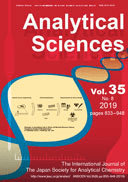
ANALYTICAL SCIENCES
Scope & Guideline
Connecting Scholars, Inspiring Innovations
Introduction
Aims and Scopes
- Innovative Analytical Techniques:
The journal showcases research that develops and optimizes new analytical methods, including novel sensors, chromatography techniques, and spectroscopic methods, enhancing sensitivity, accuracy, and efficiency. - Environmental and Food Safety Analysis:
Research addressing the detection and quantification of pollutants, toxins, and contaminants in environmental samples and food products is a core focus, reflecting the journal's commitment to public health and safety. - Biochemical and Biomedical Applications:
The journal emphasizes studies that apply analytical techniques to biological and medical fields, including drug analysis, biomarker detection, and the development of biosensors for disease diagnostics. - Nanotechnology and Material Science:
Research exploring the applications of nanomaterials and advanced materials in analytical chemistry, particularly in sensor development and environmental remediation, is a prominent theme. - Machine Learning and Data Analysis:
The integration of machine learning and computational techniques in analytical chemistry for data interpretation, method optimization, and predictive modeling is increasingly featured.
Trending and Emerging
- Advanced Sensor Development:
There is a growing trend towards the creation of highly sensitive and selective sensors for various applications, including food safety, environmental monitoring, and medical diagnostics, often utilizing nanomaterials. - Integration of Artificial Intelligence:
The application of AI and machine learning techniques for data analysis, method optimization, and predictive modeling is becoming increasingly prominent, transforming traditional analytical practices. - Microfluidics and Lab-on-a-Chip Technology:
Research focusing on microfluidic devices and lab-on-a-chip systems is on the rise, emphasizing their potential for rapid, cost-effective, and efficient analytical processes. - Sustainable Analytical Practices:
The journal is highlighting research that emphasizes green chemistry principles and sustainable methods for sample preparation and analysis, reflecting a broader commitment to environmental responsibility. - Biomolecular Detection Technologies:
Emerging technologies for the detection of biomolecules, including nucleic acid and protein detection, are increasingly featured, supporting advancements in biomedical research and diagnostics.
Declining or Waning
- Traditional Chromatographic Techniques:
There has been a noticeable decrease in publications focused solely on traditional chromatography methods, as researchers increasingly explore innovative and hybrid techniques that offer enhanced performance. - Classic Spectroscopic Techniques:
Research centered on conventional spectroscopy methods, such as UV-Vis and IR spectroscopy, is appearing less frequently as newer, more advanced spectroscopic techniques gain prominence. - Generalized Environmental Monitoring:
While environmental analysis remains important, there is a decline in studies that focus broadly on environmental monitoring without specific applications or innovative approaches. - Basic Analytical Method Validation:
The emphasis on basic validation studies for established methods has diminished, as the journal shifts toward more complex and innovative validation approaches that incorporate new technologies. - Chemical Synthesis for Analytical Applications:
Research focused solely on chemical synthesis methods without direct analytical application is declining, as the journal prioritizes studies that demonstrate clear analytical relevance.
Similar Journals

CHINESE JOURNAL OF ANALYTICAL CHEMISTRY
Catalyzing Progress in Analytical MethodologiesCHINESE JOURNAL OF ANALYTICAL CHEMISTRY, published by SCIENCE PRESS in China, stands as a prominent platform in the field of analytical chemistry since its inception in 1989. With its ISSN 0253-3820 and E-ISSN 1872-2040, the journal maintains a vital role in disseminating empirical research and innovative methodologies, contributing to the advancement of analytical techniques and their applications. The 2023 Scopus ranking positions the journal in the third quartile (Q3) within its category, reflecting a respectable standing among its peers. Researchers, professionals, and students alike engage with a broad range of topics, from instrumental analysis to environmental monitoring, each aiming to foster further scientific inquiry. Although it does not currently offer Open Access, the journal's rich repository of knowledge continues to be an essential resource for those in the analytical chemistry community, with an enduring commitment to scientific excellence and collaboration.
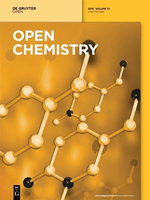
Open Chemistry
Connecting Researchers with Open Access ChemistryOpen Chemistry, published by DE GRUYTER POLAND SP Z O O, is a distinguished peer-reviewed journal that has been serving the global chemistry community since its inception. With an ISSN of 2391-5420 and an E-ISSN also of 2391-5420, this open-access journal has been accessible to researchers and practitioners alike since 2015, ensuring a wide dissemination of high-quality research findings. Located in Germany, specifically at BOGUMILA ZUGA 32A STR, 01-811 WARSAW, MAZOVIA, POLAND, Open Chemistry aims to publish innovative research across various chemical disciplines, with special attention to miscellaneous chemistry and materials chemistry. It is currently ranked in the Q3 category for both fields as of 2023, reflecting its solid standing within the academic community, with specific ranks of 187/408 in General Chemistry and 153/317 in Materials Chemistry, corresponding to respective percentiles of 54 and 51. Open Chemistry not only enhances the accessibility of cutting-edge research but also serves as a vital resource for students, professionals, and scholars seeking to advance their knowledge in the rapidly evolving landscape of chemical sciences.

CHEMOMETRICS AND INTELLIGENT LABORATORY SYSTEMS
Unlocking the future of analytical chemistry with intelligent systems.Chemometrics and Intelligent Laboratory Systems is a distinguished journal published by Elsevier, disseminating pivotal research and innovations at the intersection of analytical chemistry, computer science applications, and chemical engineering. With an impressive impact factor reflecting its scholarly influence, the journal aims to advance the development and implementation of chemometric methods, artificial intelligence, and intelligent systems in laboratory settings. Since its inception in 1986, the journal has consistently featured high-quality articles, currently positioned in the Q2 quartile across multiple relevant fields including Analytical Chemistry and Process Chemistry. Based in the Netherlands, the journal invites rigorous contributions that enhance the understanding and application of sophisticated data analysis techniques in scientific research. Although it currently does not offer open access options, the journal remains a vital resource for researchers and professionals dedicated to exploration and advancements in laboratory methodologies and analytical technologies.
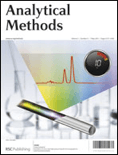
Analytical Methods
Elevating Standards in Analytical MethodologiesAnalytical Methods, published by the renowned Royal Society of Chemistry, is a distinguished journal that has been serving the scientific community since its inception in 2009. Specializing in the fields of Analytical Chemistry, Chemical Engineering, and General Engineering, this journal holds a reputable position with an impressive Q2 ranking in three relevant categories as of 2023. With its focus on innovative methodologies and advanced applications in analytical science, it aims to disseminate cutting-edge research and foster dialogue among researchers, professionals, and students. Although it is not an open access publication, it is accessible worldwide and provides critical insights into the latest developments in analytical techniques and their engineering applications. The journal also ranks highly in pertinent Scopus categories, such as being in the 77th percentile for General Engineering and 61st percentile for Analytical Chemistry, underlining its significance in advancing knowledge and practical applications in these fields. By participating in this journal, readers can expect to engage with high-quality research that influences the future of analytical practices and chemical engineering.
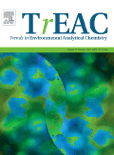
Trends in Environmental Analytical Chemistry
Leading the Charge in Analytical Chemistry TrendsTrends in Environmental Analytical Chemistry, published by Elsevier, serves as a leading platform for scholars and professionals in the fields of analytical and environmental chemistry. With an impact factor that places it in the Q1 category for both analytical chemistry and environmental chemistry, this journal attracts cutting-edge research that addresses current challenges in environmental analysis from 2014 to 2024. The journal is dedicated to advancing the knowledge base through the publication of high-quality empirical studies, innovative methodologies, and comprehensive reviews that reflect the latest trends and technological advances in the field. Operating out of the Netherlands, the journal's commitment to excellence is evident in its impressive Scopus rankings, standing as the #1 journal in Analytical Chemistry and #7 in Environmental Chemistry by percentiles. This makes it an essential resource for academics, practitioners, and students alike who are eager to stay informed on impactful environmental research and analytical techniques.
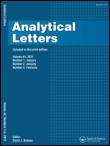
ANALYTICAL LETTERS
Exploring the Frontiers of BiochemistryANALYTICAL LETTERS is a reputable journal published by Taylor & Francis Inc, focusing on the dynamic fields of analytical chemistry, biochemistry, and clinical biochemistry. With an ISSN of 0003-2719 and an E-ISSN of 1532-236X, the journal has been a platform for scholarly articles since its inception in 1967, and is set to continue its contribution to the scientific community until 2024. Despite its classification in Q3 across various categories as of 2023, including analytical chemistry and spectroscopy, ANALYTICAL LETTERS maintains a significant impact within its field, evidenced by its moderate rankings within Scopus. This journal serves as a vital resource for researchers and professionals seeking to explore recent advancements in analytical methodologies, instrumentation, and applications, facilitating the dissemination of critical insights in laboratory practices. With access primarily through institutional subscriptions, it remains positioned as a crucial tool for those advancing knowledge and innovation in analytical sciences.

Talanta Open
Unlocking the Future of Analytical ScienceTalanta Open (ISSN: 2666-8319) is a prominent open-access journal published by Elsevier, dedicated to advancing the field of Analytical Chemistry. Established in 2020, the journal aims to foster innovative research and facilitate knowledge sharing in the analysis of chemical substances and their interactions. With an impressive Q2 ranking in the Analytical Chemistry category and a commendable Scopus ranking of #57/156, Talanta Open has quickly established itself as a vital resource for researchers, professionals, and students alike. The journal is known for its rigorous peer-review process and commitment to quality, ensuring that published content significantly contributes to the scientific community. By providing unrestricted access to high-quality research, Talanta Open underscores the importance of collaboration and accessibility in the ever-evolving landscape of analytical science.
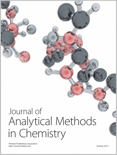
Journal of Analytical Methods in Chemistry
Advancing analytical excellence in chemistry.The Journal of Analytical Methods in Chemistry, published by HINDAWI LTD, stands as a premier platform dedicated to the dissemination of research in the vibrant field of analytical chemistry. With an ISSN of 2090-8865 and an E-ISSN of 2090-8873, this Open Access journal has been committed to providing unrestricted access to quality research since 1978, thereby fostering greater collaboration and innovation among researchers, professionals, and students globally. The journal showcases rigorous research insights spanning diverse categories, earning impressive Scopus rankings including Q2 in Chemical Engineering and Q3 in Analytical Chemistry for 2023, positioning itself effectively among respected peers. Its interdisciplinary approach also covers significant contributions in the realms of instrumentation and computer science applications, thus addressing contemporary challenges and advancements in analytical methodologies. By bridging theoretical underpinnings with practical applications, the Journal of Analytical Methods in Chemistry aims to catalyze knowledge exchange while enhancing the global discourse in analytical science.
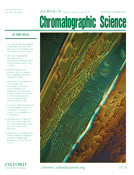
JOURNAL OF CHROMATOGRAPHIC SCIENCE
Innovating Techniques for Analytical ExcellenceWelcome to the Journal of Chromatographic Science, a premier publication dedicated to advancing the scientific understanding of chromatographic techniques and their applications across various disciplines. Published by Oxford University Press Inc, this journal, with its ISSN 0021-9665 and E-ISSN 1945-239X, has been disseminating innovative research since 1963, serving as a vital resource for researchers, industry professionals, and academic scholars in the fields of Analytical Chemistry and Medicine. As evidenced by its 2023 Scopus ranking, the journal stands at the Q3 quartile in both its primary disciplines, highlighting its relevance and contribution to ongoing research. The journal promotes high-quality, peer-reviewed articles that aim to foster knowledge and encourage the practical application of chromatographic science. While it operates under a traditional subscription model, the valuable insights it offers are essential for those seeking to enhance their expertise and stay at the forefront of chromatographic methodologies. Join our community of scholars as we explore the complexities and innovations in chromatographic science, paving the way for future discoveries.

INTERNATIONAL JOURNAL OF ENVIRONMENTAL ANALYTICAL CHEMISTRY
Empowering researchers to shape environmental solutions.INTERNATIONAL JOURNAL OF ENVIRONMENTAL ANALYTICAL CHEMISTRY, published by Taylor & Francis Ltd, stands as an essential resource in the interdisciplinary field of environmental science and analytical chemistry. With a history dating back to 1971 and a convergence period extending to 2024, this journal addresses urgent global challenges by providing a platform for high-quality research that encompasses pivotal aspects of environmental analysis, pollution, and public health. The journal’s significant impact is reflected in its 2023 rankings, placing it in the second and third quartiles across various relevant categories, including Analytical Chemistry, Environmental Chemistry, and Water Science and Technology. Researchers and practitioners are encouraged to contribute to its wealth of knowledge, making it a vital reference for emerging studies in Health, Toxicology and Mutagenesis and beyond. Although it is not an open-access journal, subscriptions provide unparalleled access to groundbreaking research that can influence both academia and industry practices.